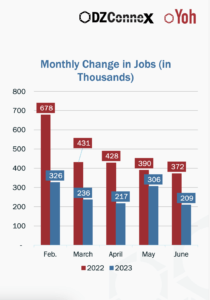For many months following the onset of the COVID-19 pandemic, economists and business experts alike made projections about what the future held for the economy and the job market. And many, for good reason, anticipated a massive recession in 2022 to 2023. But, of course, only time would tell what the actual repercussions of the onset of the pandemic would have years later. Having just passed the mid-year mark in 2023, now’s a better time than ever to consider these results—now that the numbers are in. Here are the mid-2023 results, according to a recent report from Yoh written by Kevin Yurick, of job market trends in the U.S.
Trends from the Second Quarter of 2023: An Overview
As a recent report from Yoh shows, compared to those of 2022, the job gains in 2023 have been less steep. Nevertheless, jobs have indeed been increasing each month steadily. Experts suggest that this may be a problem as the job market cools.
Still, the sustained growth we’ve seen so far suggests the economy will recover without major repercussions.
The same report from Yoh suggests that “jobs numbers are any indication, the continued growth with gradual slowdowns may signal that the economy can reach a soft landing post COVID-19 and the US can avoid a recession.”
Job Fields That Hired Most in 2023
Within the second quarter in 2023, interest rates particularly affected certain industries, such as retail, manufacturing, construction, and warehousing. This means that many of these industries have seen either a loss of jobs or a stagnation of them.
Contrastingly, however, many industries have rebounded significantly—namely, healthcare and finance.
In fact, as Yoh reports, the healthcare sector added 37,700 jobs, consistently seeking those who are highly educated. Moreover, the finance sector, including real estate, added over 12,000 jobs and insurance, over 36,000.
Lastly, the data processing, web hosting providers, and computing infrastructure industries saw a roughly 2% increase—a significant increase for these fields.
An Update on the Great Resignation
The second quarter of 2023 has also shown great news for employers: many report that the phenomenon known widely as The Great Resignation has finally begun to ease significantly, particularly in contrast to rates from 2022.

Results and graph courtesy of Yoh and DZConnex.
As Yoh reports, the number of employees voluntarily leaving their positions has decreased and stabilized overall. Still, certain sectors with highly skilled workers that may still continue to see large numbers of turnover.
These include healthcare, government, and professional & business services sectors. Less at-risk fields for resigning, however, are information, manufacturing, and finance.
What Job Seekers Need to Know
The good news? Inflation is showing some signs of improvement after a year-long decline. Gas prices seem to be easing slightly overall, and consumer price hikes are projected to similarly decrease from 4% to just over 3%.
As well, Yoh reports that part-time employment is on the rise, with about 4.2 million Americans working part-time, as of June. However, this increase, Yoh suggests, is the result of a cut-down of hours in positions that might otherwise be full-time. And this trend, they suggest, could continue to bring more full-time workers down to part-time hours.
The bad news? The second quarter of 2023 showed that Black workers faced a significantly higher rate of unemployment than other groups of workers. In fact, the number of Black people currently unemployed recently surpassed the national unemployment rate of 3.6%.
Such disproportionate rates of unemployment must inform hiring practices throughout the latter half of 2023. That is, employers should, now more than ever, be making conscious efforts to refuse biased hiring practices and actively practice diversity and inclusion within the workplace.
Stay tuned for the next update to find out where future projections will take the U.S. job market in the latter half of 2023.





